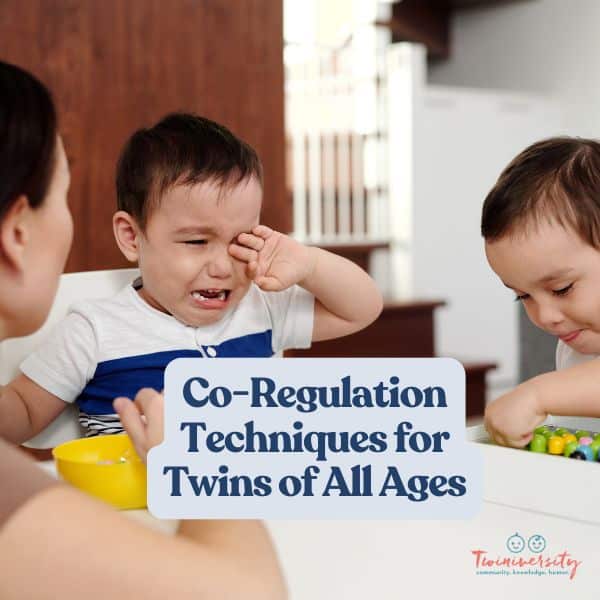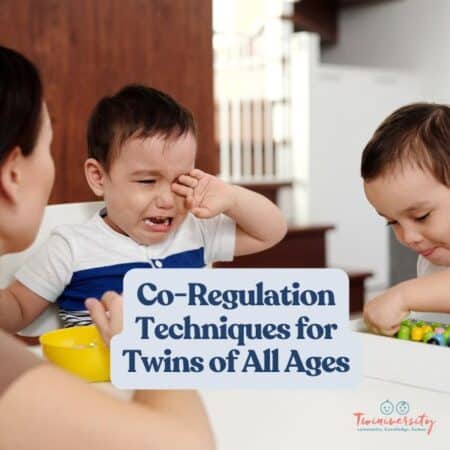
Mom rage (or dad rage) is an intense emotional response to the demands of parenting. But with two littles at once, these outbursts of anger can be even more pronounced. So learn 10 helpful ways you can learn to better manage your emotional state as a twin parent.
It’s four p.m. You’re listening to your 6th tantrum of the day (a combined total of both twins, but still about 6 too many). You still have to make dinner. You didn’t get much sleep last night (again).
Twin one is asking you non-stop questions, while twin two just spilled an entire glass of milk on the table. The milk is now dripping through the cracks in the table, raining down onto your dog’s back, who ran under the table to lick up the milk.
Covered in milk, Fido runs into the kitchen to give a good shake, spraying milk into the far corners of the cosmos. Your heart is racing, fists are clenched, and then…. you step on a Lego.

You snap before you even realize it and are once again in the throes of mom rage.
Mom rage (or dad rage) is a reality that many of us twin parents are all too familiar with. And to be honest, it often takes a lot less than a milk shower to provoke. But the truth is you are far from alone in experiencing these overwhelming emotions.
What is mom rage? And dad rage?
In recent years, mom rage has been used as a term to describe the intense emotional reactions, (such as outbursts of anger) directed at your children or partner. These feelings are overwhelming, frequent, and often disproportionate to the event that triggered them.

Need some twin parent friends? Get the support you need with a Twiniversity Membership. Benefits include a monthly twin parent club meeting on Zoom, access to a private Facebook group just for twin parents, and a video library of twin parenting lessons. Visit Twiniversity.com/membership to join today!
It’s common for mom rage to leave you feeling out of control, guilty, and even hopeless. In one study, researchers sought to gain insight into how mothers in the U.S. experience mom rage.
Here are the major categories that they saw within the pattern of responses:
- Losing control
- Visualizing harm
- Expressing anger either physically or emotionally
- Reacting physiologically
- Experiencing catharsis (an emotional release via the outburst)
As one mom from this study put it: “I feel like I am so mad that my face has to just be hideous when I scream and I do feel like a literal monster in that moment.” (Amira, mom of 2)
While mom rage is given more attention by researchers and mental health professionals, similar feelings can be felt by dads and other parental figures too.
If you’ve experienced these intense emotions yourself, you can attest to how suddenly the rage can take over. As well as the aftermath of feeling down on yourself. But why are mom rage and dad rage becoming so rampant?
What causes mom rage?
The reality is that there are a lot of reasons that mom rage and dad rage manifest. Twin parents especially can become overstimulated, over-tired, and perpetually busy and stressed. At times, parenting can feel like a thankless job. This can be heightened for mothers in particular due to the heightened pressures of historical and societal gender roles.
All of that coupled with the impossible expectations of parenthood in our modern world, and it’s no wonder a Lego can trigger feelings of rage.

I was very relieved when I first read about mom rage because it meant I was not alone in experiencing it. Not only is it a common and shared experience, but there are very effective and practical things you can do to manage your emotions and improve your responses
Here are some ideas and tools to help tame the rage monster before it sneaks up on you again:
1. Practice self-awareness and name your feelings
Becoming aware of your feelings is easier said than done. But in order to be able to improve your emotional responses, you must first be in tune with what’s going on.
The most basic place to start is to begin to recognize when your breathing and heart rate start to change. This is the first sign that you are exhibiting physiological signs of escalation. These changes may happen before your brain even recognizes you are irritated.
If you can notice when your muscles tighten, your breathing becomes shallow and faster, and your heart rate increases, you can start to take steps to calm down. Usually, anger starts off as irritation, annoyance, or frustration and progresses from there. Put a name to these feelings that precede your anger so you can recognize them and take control proactively.
There is a model in behavioral health known as the aggression cycle. Although outbursts of anger seem unpredictable, they actually follow a pattern of phases that begin with a triggering event, followed by escalation, and then a “crisis.”
In this case, the crisis is an angry burst of mom or dad rage. The earlier in the cycle you are able to intentionally intervene, the easier it is to regain self-control and calm down. In other words, it is easier to put out a small fire than a raging inferno.
2. Identify triggers
Start to notice the things that happen right before you escalate into mom or dad rage. Also notice the time of day and where you are in your daily routine. Notice contributing stressors like fatigue and hunger.
These triggers can be caused by things other people do, by our environment, by something going on inside you, or a combination.
For instance: Are you triggered by whining? Are you triggered by your kids not listening? Do you react to things worse in the afternoon because you have low blood sugar? Are you triggered by loud noises or by too many questions and demands from your kids?

I noticed I got very snappy with my twins every day when we got home from school. It stemmed from feeling over-stimulated. I had a million things in my hands walking in the door. They instantly started whining for food and asking me questions. The dog was barking. I couldn’t even think straight with all of the external stimuli.
Identifying this helped me come up with a solution. I asked that my twins not say anything to me for the first 5 minutes of getting home so I could set things down and get organized. I even started setting a timer. During this time, they now take their shoes off and wash their hands, and I regained at least 5 minutes of sanity in my day.
Once you identify your triggers, you can anticipate them and figure out ways to make them less triggering. Maybe you can’t avoid loud places or tantrums altogether, but you can use noise-reducing earplugs to muffle the sound.
3. Learn how you calm down best
It will definitely take some practice, but once you become more aware of your triggers, you can learn to stop mom or dad rage in its tracks.
If possible, go for a quick walk, sit in a rocking chair for 5 minutes, or repeat a helpful mantra. Deep, slow breathing can help return your body to baseline. Learn the tapping technique in which you tap on different parts of your body to reduce anxiety. Pressure points, such as between your eyebrows or the webbing between your thumb and index finger, can have a relaxing effect too.
If you can’t get away, pop in some headphones and listen to some quick relaxation music before tuning back in to your kids. The idea is to stop mom rage before or during the escalation phase.

Also, take note of how long it actually takes you to return to baseline. I know that if I become really upset with my kids, it takes me around 20 minutes before my heart rate is normal and I no longer see red. If I don’t give myself enough time, I risk starting the cycle over again and escalating again too easily.
4. Change the way you react or change the situation
Maybe it’s not realistic to expect yourself to stay calm, cool, and collected in the face of 20 tantrums a day. Instead, evaluate the need to change the situation.
Maybe it’s the 20 tantrums that need to change, and that may require a form of professional therapy or intervention for your children.
Is it realistic to expect to stay calm after your kids wake you up night after night? No. But maybe there are sleep issues you can address with a doctor or sleep coach. We are only human, and mom rage is only one part of the puzzle.
5. Look inward
Anger often stems from underlying emotions such as fear, sadness, anxiety, or a feeling of losing control. It may be worth asking if there is a deeper reason that your triggers are causing anger.
Ask yourself: What feels like it’s being threatened when I experience anger?
When you yell at your kids, it may be because their safety is at risk and that causes deep fear for you. When you get frustrated with them for taking too long getting out of the car, it may be because you are afraid of losing control over the schedule or that getting behind means the time you have to yourself later is threatened.

Got twins? Us too! The Twiniversity Podcast with Natalie Diaz was created BY parents of twins FOR parents of twins, from your pregnancy days through your twin’s teenage years, this podcast covers it all. It’s all about parenting twins, offering plenty of strategies for making life better, parenting hacks, and, of course, humor. We are laughing WITH you every step of the way.
It could be the anxiety about not getting everything done. We may get angry when kids disobey and talk back because it hurts and frustrates us, making us feel like we’re not doing a good job at the whole parenting thing. It may even cause fear about their character.
6. Be the example
It takes a strong personal reason to want to stay calm and fend off mom rage. For me, I think of it as setting an example for my twins.
If I am trying to teach my kids how to handle tantrums, I know I cannot exhibit the same uncontrollable outbursts. They do as I do. If they are throwing a tantrum or fighting with each other, I remember that I need to stay calm so I can show them how to stay calm.
We can even try to calm down together through co-regulation strategies like deep breathing. Our motto is, “The first step in solving a problem is to calm down.” Fighting fire with fire does nothing but create more fire!
7. Size the problem
Another toddler-approved method of staying calm is to evaluate the size of the problem and decide how much emotion you’re going to assign to your reaction.
Is it a big problem or a little problem? Does it warrant a big reaction, or is it not that big of a deal? This helps put things into perspective.
Anger activates the body’s “fight or flight” response system (racing heart, stress hormone release, muscle tension). But when we start to consciously think through a problem, it activates the logical part of the brain. This can help promote a rational response rather than an uncontrolled emotional response (like mom rage or dad rage).

8. A state of calm
If you are constantly stressed, you are going to be triggered into anger more easily and escalate more quickly. No matter how good your intentions may be.
Mental health, especially as a twin parent, takes a lot of daily maintenance. Doing something daily that is relaxing and rejuvenating is vital for resetting and maintaining a baseline level of calm. Also, it helps to reflect on how you approach the day overall and what causes you the most stress.
I had to realize I was rushing my family from task to task and projecting a lot of anxiety onto them. So I took a step back and really examined my reasons for rushing. I felt like I always had so much to do, and if I could just get to the next thing, to the next place, through the next meal, to the next task, it would be one less thing on my list.
If we got behind at dinner, then bedtime would be behind, and I feared I would not get to relax after my kids went to bed. When my kids even took too long to buckle into the car or got distracted brushing their teeth, it really sent me over the edge.
Obviously, this was no way to live. It took a lot of self-examination to figure out the reason “dilly-dallying” caused me so much anxiety and anger, and only then could I change my overall approach to each day.
I still catch myself trying to rush, but at least now I recognize it and try to slow down and enjoy the moment without thinking about the next step. Even if this means we meander through our day.
9. Emergency stress gadgets
Carry some helpful tools with you for mom rage emergencies. These tools could include anything you find helpful such as earplugs, snacks, headphones with a calming song queued up, a stress ball, aromatherapy scents, or a breathing straw.
Something you can pull out quickly to assist your efforts to stay calm. Raising twins requires the patience of a saint and yet somehow none of us have that!

10. Therapy, therapy, for all!
I personally believe there is no one on Earth who cannot benefit from a little therapy. Therapists can help us understand triggers, risk factors, and coping skills specific to mom rage and dad rage.
They can talk through difficult situations and offer perspective and support that we otherwise can’t reach when we try to do it all on our own. There are all sorts of different types of therapy depending on your specific needs.
Twiniversity tip: Go through your health insurance to help you find someone in your network, or look for a therapist that offers a sliding-scale for payments.

Final thoughts on mom rage
If you experience mom rage or dad rage, it doesn’t mean you’re a bad parent. But it doesn’t feel good to have those outbursts of anger, so know that there are steps within your power to reclaim control of your emotions.
Dealing with mom rage brought me back to the basics that I try to teach my kids about emotional regulation: practice self-awareness, name your feelings, and identify the size of the problem. Next, we practice things like deep breathing to calm our bodies, knowing that our minds will follow.
The good news is that as an adult, once you become aware of your triggers and responses, it is so much easier to calm down before things escalate past the point of no return.
We may become more complicated as we get older, but the basics of emotional regulation remain pretty much the same. Anger is a completely normal human emotion, and in fact, it usually means we care a lot.
What makes all the difference is how we handle that anger. Be gracious with yourself through your parenting journey. And hopefully, keeping a few of these tricks in your pocket, as well as remembering to put the Legos away, will help keep the twin mom rage at bay!
Want to read more articles about coping with the struggles of twin parenthood? Check these out too:
- Postpartum Depression and Anxiety: What You Need to Know
- How to Keep Your Cool: Stress Management for Parents of Twins
- Birth Trauma and the Invisible Scars We Carry From It

Maddison Ellison is a mom to vibrant and mischievous twin toddler girls. She works as a nurse in the Denver metro area and enjoys getting outside with her twins, husband, and sheepadoodle, Rosie. Maddison is inspired by health, wellness, the magic of everyday life, and of course, coffee.










